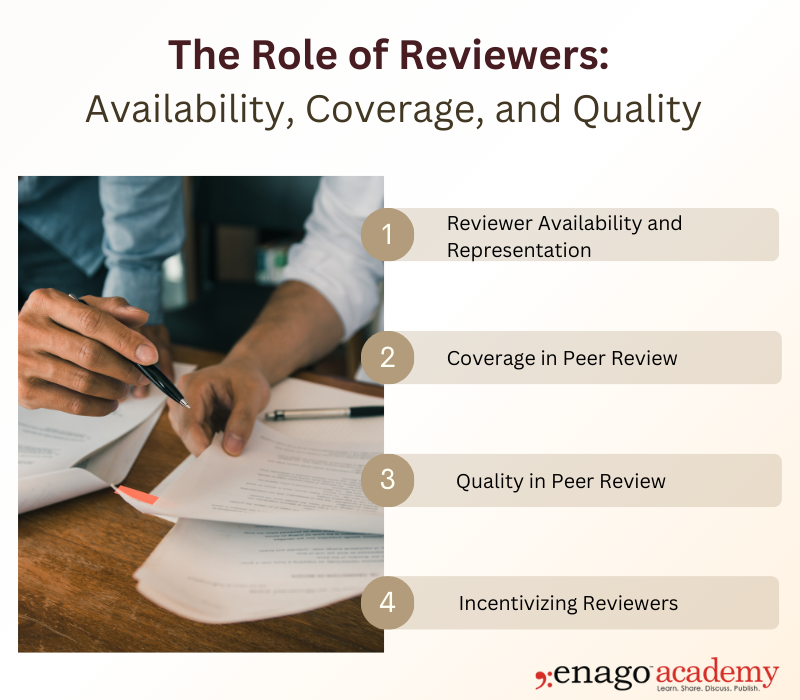Celebrating Open Access Week 2024: A deep dive into the current state of open access publishing and the role of peer review

Each year, Open Access Week brings attention to the transformative power of open access (OA) publishing, shining a spotlight on the evolving relationship between research, technology, and public access. In 2024, as we celebrate Open Access Week, it’s a perfect time to reflect on where OA publishers stand today — their challenges, successes, the critical role of peer reviewers, and the road ahead in shaping the future of academic publishing.
The Current Landscape of Open Access Publishing
Open access publishing has grown dramatically over the past decade. According to recent estimates, more than 50% of newly published research articles are now openly accessible, a significant increase from previous years. OA publishers like PLOS, BioMed Central, Frontiers, and newer initiatives like eLife are pioneering efforts to democratize research access, especially in fields like medicine, life sciences, and social sciences. The push towards OA is driven by a fundamental belief: research funded by public money should be freely available to the public. However, open access today isn’t just about removing paywalls — it has become a multifaceted ecosystem with a variety of models:
 While the rise of OA has been significant, it has not come without challenges.
While the rise of OA has been significant, it has not come without challenges.
Challenges Facing OA Publishers in 2024
1. Sustainability and Costs:
A primary hurdle for many OA publishers is the financial sustainability of their operations. Gold OA often relies on APCs, but this has led to a new debate — shifting the financial burden from readers to authors, particularly disadvantaging researchers from low- and middle-income countries. Even diamond OA, while equitable, relies heavily on external funding that may not always be available.
2. Predatory Publishers:
The rise of OA has given rise to predatory journals that exploit the APC model without providing legitimate editorial and peer-review support. These publishers damage the credibility of OA publishing, despite efforts to regulate and create transparency through organizations like the Directory of Open Access Journals (DOAJ) and Cabells international.
3. Equity and Inclusion:
While OA promises to make research universally accessible, the costs associated with publishing in high-quality OA journals create inequities. Researchers from underfunded institutions or developing countries often struggle to cover APCs, limiting their ability to participate fully in the global academic conversation.
4. Repository Fragmentation:
OA publishing relies heavily on a decentralized network of institutional and subject-specific repositories. However, the lack of standardization across repositories means that access to research is often uneven, leading to a fragmented OA landscape.
5. Intellectual Property and Licensing:
Licensing remains complex, with OA publishers opting for different versions of Creative Commons licenses. This variety can cause confusion among users about what they can and cannot do with the content.
 The Role of Reviewers: Availability, coverage, and quality
The Role of Reviewers: Availability, coverage, and quality
As OA publishing grows, the role of reviewers in maintaining the quality and integrity of scholarly work has become more critical. However, the increasing volume of submissions presents new challenges.
1. Reviewer Availability and Representation:
The demand for peer reviewers is growing alongside the surge in OA articles, leading to issues such as reviewer fatigue. Many academics face significant time constraints, struggling to balance research, teaching, and service responsibilities with reviewing. This strain is particularly felt in disciplines with high submission rates, making it difficult to find enough qualified reviewers. Additionally, there is underrepresentation of reviewers from certain regions and disciplines, especially in emerging fields, which can delay the peer review process and limit the diversity of perspectives.
2. Coverage in Peer Review:
Ensuring comprehensive peer review coverage is essential for maintaining high-quality standards. However, interdisciplinary research — a hallmark of many OA journals — poses challenges in finding reviewers with cross-disciplinary expertise. There is also a growing need for global inclusion, as OA journals aim to represent a wide array of voices across the world, but disparities in reviewer availability from developing regions can impact coverage.
3. Quality in Peer Review:
Maintaining quality in peer review is crucial, especially for OA journals combating the reputation damage caused by predatory publishers. Initiatives like Cabells’ predatory reports and PredatoryJournals.org have helped regulate quality standards, but ensuring thorough, unbiased, and rigorous review remains essential. Open peer review practices —where reviewer reports are made public — have been adopted by some OA journals to enhance transparency and accountability in the review process. Furthermore, the rise of AI-assisted peer review tools helps streamline manuscript evaluation, assisting human reviewers in maintaining high standards while managing the increasing workload.
4. Incentivizing Reviewers:
One of the critical issues in peer review is the lack of formal incentives. Peer reviewers typically volunteer their time without financial compensation. To address reviewer fatigue and maintain high-quality reviews, some OA publishers are experimenting with incentives like recognition badges, discounted APCs, or formal credit systems. However, these efforts are still evolving, and finding sustainable ways to reward reviewers is an ongoing challenge.
 Wins and Recent Developments
Wins and Recent Developments
Despite these challenges, there have been remarkable successes for OA publishers:
1. Transformative Agreements:
More universities and consortia are entering into transformative agreements with large publishers like Elsevier and Springer Nature, allowing authors to publish OA without incurring individual APCs. These agreements aim to shift subscription-based models to OA, making it easier for researchers to publish openly while ensuring institutional financial support.
2. Growth of Preprint Servers:
Preprint platforms like arXiv, bioRxiv, and PsyArXiv have continued to flourish, allowing researchers to share their findings quickly and openly before formal peer review. Preprints enhance the speed of knowledge dissemination and offer a free, accessible layer of OA for researchers and the public.
3. Institutional and National Support:
Governments and institutions worldwide are increasingly implementing policies that mandate open access to publicly funded research. Initiatives like the cOAlition S’s Plan S and European Union’s Horizon 2020 has led the charge, and the US government announced new policies requiring that all federally funded research be made freely available to the public without embargo.
4. Technological Advancements:
Online resources such as Unpaywall, CORE, and Google Scholar are making OA research more discoverable. Meanwhile, some OA publishers are using AI and blockchain technology to enhance the peer review process, ensuring quality and transparency.
5. Increasing Impact:
Open access articles continue to receive more citations and greater visibility compared to paywalled content, contributing to faster knowledge transfer and fueling innovation in areas like health and climate change.
The Road Ahead: Future Opportunities
The future of open access holds immense potential, but it will require continued collaboration and innovation to address ongoing challenges.
1. New Funding Models:
As reliance on APCs comes under scrutiny, there’s growing interest in alternative funding models for OA, such as crowdfunding for research publications, institutional subsidies, or international grants for low-income researchers. Initiatives like the Open Access Publishing Cooperative aim to create community-driven funding strategies.
2. Increased Collaboration:
OA publishers and traditional subscription-based journals must work together on hybrid models and transformative agreements to smooth the transition to full open access.
3. Global Reviewer Networks:
Encouraging and training reviewers from underrepresented regions is crucial for ensuring equity in the peer review process. Mentorship programs and regional networks could help overcome barriers to participation, fostering a more inclusive peer review ecosystem.
4. Leveraging Technology:
AI, blockchain, and other technologies will likely play a growing role in automating and enhancing peer review processes, reducing workloads, and maintaining high-quality standards.
5. Leveraging Partnerships:
Partnerships with vendors experienced in quality control and editorial desk will ensure more efficient and high-quality peer review processes, reducing backlogs and again maintaining high-quality standards.
Conclusion
As we celebrate Open Access Week 2024, it’s important to recognize both the achievements and the ongoing challenges faced by open access publishers. The landscape of scholarly publishing is undergoing a transformation, with OA at the forefront of this change. While there are still hurdles to overcome — particularly around financial sustainability, equity, and maintaining high academic standards — the momentum is undeniable.
A critical part of this transformation is the role of peer reviewers, whose work ensures that OA research remains rigorous, transparent, and impactful. Their availability, commitment to comprehensive coverage, and dedication to quality are indispensable. As the OA movement continues to evolve, supporting and incentivizing reviewers will be crucial for ensuring the long-term success and integrity of open access publishing. The road ahead promises a more inclusive, transparent, and accessible future for research, driven by the spirit of open knowledge sharing that defines the open access movement.
References
- Piwowar, Heather, Jason Priem, Vincent Larivière, Johan P. Alperin, Lisa Matthias, and others. “The State of OA: A Large-Scale Analysis of the Prevalence and Impact of Open Access Articles.” PeerJ, 2018. https://doi.org/10.7717/peerj.4375.
- Tennant, Jonathan P., François Waldner, Damien C. Jacques, Paola Masuzzo, Lauren B. Collister, and Chris H. J. Hartgerink. “The Academic, Economic, and Societal Impacts of Open Access: An Evidence-Based Review.” F1000Research 5 (2016): 632. https://doi.org/10.12688/f1000research.8460.3.
- Unpaywall. “Unpaywall Dataset: An Open Database of 32 Million Scholarly Articles.” Accessed October 18, 2024. https://unpaywall.org/.
- cOAlition S. “Plan S: Making Full and Immediate Open Access a Reality.” Accessed October 18, 2024. https://www.coalition-s.org.
- European Commission. “Open Access Policy for Horizon 2020: Open Access to Scientific Publications.” Accessed October 18, 2024. https://ec.europa.eu/research/openscience/index.cfm?pg=openaccess.
- UNESCO. “Global Open Access Portal (GOAP).” Accessed October 18, 2024. https://www.unesco.org/en/communication-information/portals-platforms/goap.





 The Role of Reviewers: Availability, coverage, and quality
The Role of Reviewers: Availability, coverage, and quality Wins and Recent Developments
Wins and Recent Developments



